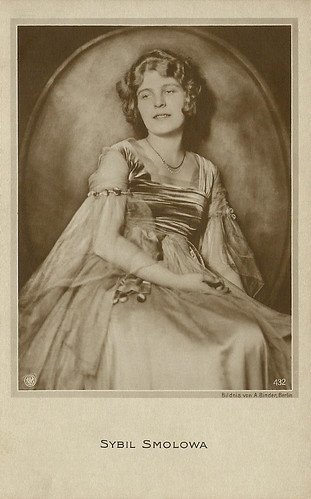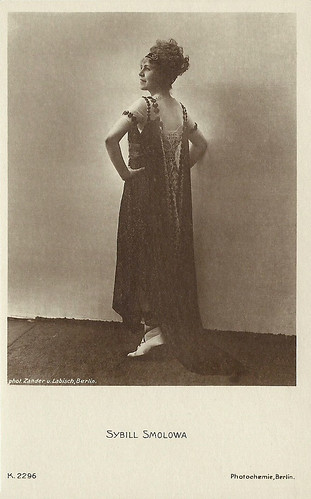Sybil Smolowa (1886-1972) was an Austrian-Czech dancer and film actress. She started as a dancer in Riga and Warsaw and then moved to Berlin. In the 1910s and 1920s, she appeared in several Danish and German silent films. One of her last films was the lesbian-themed Anna und Elisabeth/Anna and Elisabeth (1933).

German postcard by Photochemie, Berlin, no. K. 145. Photo: Alex Binder, Berlin.

German postcard by Photochemie, Berlin, no. K. 146. Photo: Alex Binder, Berlin.

German postcard by NPG. no. 432. Photo: Alex Binder. Collection: Didier Hanson.
Sybil Smolowa (or Sybill Smolowa, Sibyl Smolova and Sybil Smolova) was born Anna Marie Josefa Smolová in 1886 in Chlumetz an der Cidlina, Austria-Hungary (according to IMDb, she was born in Prague). She was the daughter of the innkeeper Benjamin Smola and his wife Anna, née Jarkovská, and grew up in the small village of Val in the foothills of the Orlické Mountains. Her brother was the stage actor and stage director Benjamin Smola. She studied fine arts in Dresden and Vienna and took acting lessons with Karel Želenský.
In 1910 she appeared - at that time still as Anneta Smolová - at literary evenings in the context of the Moderní revue in Prague, attracting the attention of Franz Kafka and Max Brod, who considered her “a particularly great talent”. The Czech writer Miloš Marten dedicated two works to her and suggested the stage name, Sibyl.
Through the mediation of the playwright František Zavřel, Smolowa soon received an engagement with Max Reinhardt in Berlin, where she again attracted the interest of leading figures in the artistic scene. Alfred Kerr described his meeting with her, which was arranged by Edgar Varèse, in the magazine Pan. Klabund dedicated two poems to her as well as his story 'The Illness', whose main character, the fictional actress Sybil Lindquist, is probably a homage to her.
Sybil Smolowa was engaged at the Lessing Theater in Berlin. After playing Solveig in a performance of 'Peer Gynt', she was engaged for the leading female role in the sensational Science Fiction film Der Schienenweg unterm Ozean / The Railway under the Ocean (Siegfried Dessauer, Kurt Matull, 1914), based on the novel 'Der Tunnel' (1913) by Bernhard Kellermann. The production costs totalled around 180,000 Marks.
Actor-director Friedrich Zelnik spotted her and she appeared opposite him in the film Seelen, die sich nachts begegnen / Souls who Meet at Night (Eugen Illés, 1915), produced by the Danish studio Atlantic. Smolowa played a rich girl who gets 'in shame' (pregnant). Happily, she meets a student (Zelnik) who takes care of her and teaches her to love. From then on, the white-blonde artist found her main activity in silent films, where she preferred to play “strong dramatic, very fantastic roles for women and girls” (Die Frau im Film, p. 22).

German postcard by Verlag Hermann Leiser, Berlin-Wilm, no. 9821. Photo: Elli Lisser, Berlin W.

German postcard by Verlag Hermann Wolff, Berlin, no. F. 70. Photo: A. Binder, Berlin.
Sybil Smolowa co-starred with Eduard von Winterstein, Erika Glässner and Reinhold Schünzel in the silent German drama Werner Krafft (Carl Froelich, 1916), produced by Oskar Messter. In Sweden, Smolowa made Vägen utför / The Road Downhill (Georg af Klercker, 1916) and I mörkrets bojor / In the Fetters of Darkness (Georg af Klercker, 1917).
Then followed films like Im Schatten des Glücks / In the Shadow of Happiness (Robert Leffler, 1919) with Hans Adalbert Schlettow, and the two-partner Kinder der Finsternis / Children of Darkness (Ewald André Dupont, 1922) with Grit Hegesa and Hans Mierendorff.
From the mid-1920s, things became quieter for the Czech actress, who shifted the focus of her artistic activities back to the stage. She performed at the Deutsches Theater Berlin, Renaissance Theater, and Theater in der Klosterstraße.
After the Nazis seized power, she remained in the German capital and appeared in two of Frank Wysbar's films the lesbian-themed sound film Anna und Elisabeth / Anna and Elisabeth (Frank Wysbar, 1933) with Dorothea Wieck and Hertha Thiele, and the Horror film Fährmann Maria / Ferryman Maria (Frank Wysbar, 1934) starring Sibylle Schmitz.
In 1934, she was also heard in a live radio reading of detective plays. After her Berlin apartment was bombed out in an air raid in 1943, she returned to her homeland and initially went to Prague. After the end of the war, she moved back to Val, where she joined the local amateur theatre group. Sybil Smolowa spent the last years of her life with her niece in Prague. She died in 1972 in the Bohnice Psychiatric Clinic in Prague, Czechoslovakia, and was buried in the Krem.

German postcard by NPG, no. 935. Photo: Elli Lisser, Berlin.

German postcard by Photochemie, Berlin, no. 2296. Photo: Zander & Labisch, Berlin. Collection: Didier Hanson.
Sources: Thomas Staedeli (Cyranos), Wikipedia (German and English) and IMDb.

German postcard by Photochemie, Berlin, no. K. 145. Photo: Alex Binder, Berlin.

German postcard by Photochemie, Berlin, no. K. 146. Photo: Alex Binder, Berlin.

German postcard by NPG. no. 432. Photo: Alex Binder. Collection: Didier Hanson.
In shame
Sybil Smolowa (or Sybill Smolowa, Sibyl Smolova and Sybil Smolova) was born Anna Marie Josefa Smolová in 1886 in Chlumetz an der Cidlina, Austria-Hungary (according to IMDb, she was born in Prague). She was the daughter of the innkeeper Benjamin Smola and his wife Anna, née Jarkovská, and grew up in the small village of Val in the foothills of the Orlické Mountains. Her brother was the stage actor and stage director Benjamin Smola. She studied fine arts in Dresden and Vienna and took acting lessons with Karel Želenský.
In 1910 she appeared - at that time still as Anneta Smolová - at literary evenings in the context of the Moderní revue in Prague, attracting the attention of Franz Kafka and Max Brod, who considered her “a particularly great talent”. The Czech writer Miloš Marten dedicated two works to her and suggested the stage name, Sibyl.
Through the mediation of the playwright František Zavřel, Smolowa soon received an engagement with Max Reinhardt in Berlin, where she again attracted the interest of leading figures in the artistic scene. Alfred Kerr described his meeting with her, which was arranged by Edgar Varèse, in the magazine Pan. Klabund dedicated two poems to her as well as his story 'The Illness', whose main character, the fictional actress Sybil Lindquist, is probably a homage to her.
Sybil Smolowa was engaged at the Lessing Theater in Berlin. After playing Solveig in a performance of 'Peer Gynt', she was engaged for the leading female role in the sensational Science Fiction film Der Schienenweg unterm Ozean / The Railway under the Ocean (Siegfried Dessauer, Kurt Matull, 1914), based on the novel 'Der Tunnel' (1913) by Bernhard Kellermann. The production costs totalled around 180,000 Marks.
Actor-director Friedrich Zelnik spotted her and she appeared opposite him in the film Seelen, die sich nachts begegnen / Souls who Meet at Night (Eugen Illés, 1915), produced by the Danish studio Atlantic. Smolowa played a rich girl who gets 'in shame' (pregnant). Happily, she meets a student (Zelnik) who takes care of her and teaches her to love. From then on, the white-blonde artist found her main activity in silent films, where she preferred to play “strong dramatic, very fantastic roles for women and girls” (Die Frau im Film, p. 22).

German postcard by Verlag Hermann Leiser, Berlin-Wilm, no. 9821. Photo: Elli Lisser, Berlin W.

German postcard by Verlag Hermann Wolff, Berlin, no. F. 70. Photo: A. Binder, Berlin.
Lesbian-themed sound film
Sybil Smolowa co-starred with Eduard von Winterstein, Erika Glässner and Reinhold Schünzel in the silent German drama Werner Krafft (Carl Froelich, 1916), produced by Oskar Messter. In Sweden, Smolowa made Vägen utför / The Road Downhill (Georg af Klercker, 1916) and I mörkrets bojor / In the Fetters of Darkness (Georg af Klercker, 1917).
Then followed films like Im Schatten des Glücks / In the Shadow of Happiness (Robert Leffler, 1919) with Hans Adalbert Schlettow, and the two-partner Kinder der Finsternis / Children of Darkness (Ewald André Dupont, 1922) with Grit Hegesa and Hans Mierendorff.
From the mid-1920s, things became quieter for the Czech actress, who shifted the focus of her artistic activities back to the stage. She performed at the Deutsches Theater Berlin, Renaissance Theater, and Theater in der Klosterstraße.
After the Nazis seized power, she remained in the German capital and appeared in two of Frank Wysbar's films the lesbian-themed sound film Anna und Elisabeth / Anna and Elisabeth (Frank Wysbar, 1933) with Dorothea Wieck and Hertha Thiele, and the Horror film Fährmann Maria / Ferryman Maria (Frank Wysbar, 1934) starring Sibylle Schmitz.
In 1934, she was also heard in a live radio reading of detective plays. After her Berlin apartment was bombed out in an air raid in 1943, she returned to her homeland and initially went to Prague. After the end of the war, she moved back to Val, where she joined the local amateur theatre group. Sybil Smolowa spent the last years of her life with her niece in Prague. She died in 1972 in the Bohnice Psychiatric Clinic in Prague, Czechoslovakia, and was buried in the Krem.

German postcard by NPG, no. 935. Photo: Elli Lisser, Berlin.

German postcard by Photochemie, Berlin, no. 2296. Photo: Zander & Labisch, Berlin. Collection: Didier Hanson.
Sources: Thomas Staedeli (Cyranos), Wikipedia (German and English) and IMDb.
No comments:
Post a Comment